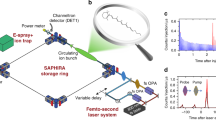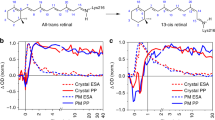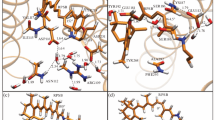Abstract
For the photocycle of the membrane protein bacteriorhodopsin to proceed efficiently, the thermal 13-cis to all-trans back-isomerization of the retinal chromophore must return the protein to its resting state on a time-scale of milliseconds. Here, we report on quantum mechanical/molecular mechanical energy calculations examining the structural and energetic determinants of the retinal cis–trans isomerization in the protein environment. The results suggest that a hydrogen-bonded network consisting of the retinal Schiff base, active site amino acid residues, and water molecules can stabilize the twisted retinal, thus reducing the intrinsic energy cost of the cis–trans thermal isomerization barrier.






Similar content being viewed by others
References
Belrhali H, Nollert P, Royant A, Menzel C, Rosenbusch JP, Landau EM, Pebay-Peyroula E (1999) Protein, lipid and water organization in bacteriorhodopsin crystals: a molecular view of the purple membrane at 1.9 Å resolution. Structure 7:909–917
Bondar A-N, Elstner M, Suhai S, Smith JC, Fischer S (2004) Mechanism of primary proton transfer in bacteriorhodopsin. Structure 12:1281–1288
Bondar A-N, Fischer S, Suhai S, Smith JC (2005a) Tuning of retinal twisting in bacteriorhodopsin controls the directionality of the early photocycle steps. J Phys Chem B 109:14786–14788
Bondar A-N, Smith JC, Fischer SK (2005b) QM/MM investigation of the hydrogen-bonding interactions in putative K and early-M intermediates of the bacteriorhodopsin photocycle. Phase Trans 78:671–675
Bondar A-N, Suhai S, Fischer S, Elstner M (2007) Suppression of the back proton-transfer from Asp85 to the retinal Schiff base in bacteriorhodopsin: a theoretical analysis of structural elements. J Struct Biol 157:454–469
Bondar A-N, Baudry J, Suhai S, Fischer S, Smith JC (2008) Key role of active-site water molecules in bacteriorhodopsin proton-transfer reactions. J Phys Chem B 112:14729–14741
Bondar A-N, Knapp-Mohammady M, Suhai S, Fischer S, Smith JC (2011) Ground-state properties of the retinal molecule: from quantum mechanical to classical mechanical computations of retinal proteins. Theor Chem Acc 130:1169–1183
Brooks BR, Bruccoleri RE, Olafson BD, States DJ, Swaminathan S, Karplus M (1983) CHARMM: a program for macromolecular energy, minimization, and dynamics calculations. J Comput Chem 4:187–217
Chen D, Wang JM, Lanyi JK (2007) Electron paramagnetic resonance study of structural changes in the O photointermediate of bacteriorhodopsin. J Mol Biol 366:790–805
Choi C, Elber R (1991) Reaction path study of helix formation in tetrapeptides: effect of side chains. J Chem Phys 94:751–760
Cui Q, Elstner M, Kaxiras E, Frauenheim T, Karplus M (2001) A QM/MM implementation of the self-consistent charge density functional tight binding (SCC-DFTB) method. J Phys Chem B 105:569–585
Delaney JK, Schweiger U, Subramaniam S (1995) Molecular mechanism of protein-retinal coupling in bacteriorhodopsin. Proc Natl Acad Sci USA 92:11120–11124
Elstner M, Porezag D, Jungnickel G, Elsner J, Haugk M, Frauenheim T, Suhai S, Seifert G (1998) Self-consistent-charge density functional tight-binding method for simulations of complex materials properties. Phys Rev B 58:7260–7268
Elstner M, Frauenheim T, Kaxiras E, Seifert G, Suhai S (2000) A self-consistent-charge density functional based tight-binding scheme for large biomolecules. Phys Stat Sol B 217:357–376
Field MJ, Bash PA, Karplus M (1990) A combined quantum mechanical and molecular mechanical potential for molecular dynamics simulations. J Comput Chem 11:700–733
Fischer S, Karplus M (1992) Conjugate peak refinement: an algorithm for finding reaction paths and accurate transition states in systems with many degrees of freedom. Chem Phys Lett 194:252–261
Gerber PR, Müller K (1995) MAB, a generally applicable molecular force field for structure modelling in medicinal chemistry. J Comput Aided Mol Des 9:251–268
Herzfeld J, Lansing JC (2002) Magnetic resonance studies of the bacteriorhodopsin pump cycle. Annu Rev Biophys Biomol Struct 31:73–95
Jorgensen W, Chandrasekhar J, Madura J, Impey R, Klein M (1983) Comparison of simple potential functions for simulating liquid water. J Chem Phys 79:926–935
König PH, Hoffmann M, Frauenheim T, Cui Q (2005) A critical evaluation of difference QM/MM frontier treatments with SCC-DFTB as the QM method. J Phys Chem B 109:9082–9095
Lanyi JK (2004) Bacteriorhodopsin. Ann Rev Physiol 66:665–688
Lanyi JK, Schobert B (2003) Mechanism of proton transport in bacteriorhodopsin from crystallographic structures of the K, L, M\(_1\), M\(_2\), and M\(_2\)’ intermediates of the photocycle. J Mol Biol 328:439–450
Ludmann K, Gergely C, Váró G (1998) Kinetic and thermodynamics study of the bacteriorhodopsin photocycle over a wide pH range. Biophys J 75:3110–3119
Luecke H (2000) Atomic resolution structures of bacteriorhodopsin photocycle intermediates: the role of discrete water molecules in the function of this light-driven ion pump. Biochim Biophys Acta 1460:133–156
Luecke H, Schobert B, Richter HT, Cartailler J-P, Lanyi JK (1999) Structure of bacteriorhodopsin at 1.55 angstrom resolution. J Mol Biol 291:899–911
MacKerell AD Jr, Bashford D, Bellott M, Dunbrack RL Jr, Evanseck JD, Field MJ, Fischer S, Gao J, Guo H, Ha S, Joseph-McCarthy D, Kuchnir L, Kuczera K, Lau FTK, Mattos C, Michnick S, Ngo T, Nguyen DT, Prodhom B, Reiher WE III, Roux B, Schlenkrich M, Smith JC, Stote R, Straub J, Watanabe M, Wiórkiewicz-Kuczera J, Yin D, Karplus M (1998) All-atom empirical potential for molecular modeling and dynamics studies of proteins. J Phys Chem B 102:3586–3616
Mathies RA, Lin SW, Ames JB, Pollard WT (1991) From femtoseconds to biology: mechanism of bacteriorhodopsin’s light-driven proton pump. Annu Rev Biophys Biophys Chem 20:491–518
Nango A, Royant A, Kubo M, Nakane T, Wickstrand C, Kimura T, Tanaka T, Tono K, Song C, Tanaka R, Arima T, Yamashita A, Kobayashi J, Hosaka T, Mizohata E, Nogly P, Sugahara M, Nam D, Nomura T, Shimamura T, Im D, Fujiwara T, Yamanaka Y, Jeon B, Nishizawa T, Oda K, Fukuda M, Andersson R, Bøath P, Dods R, Davidsson J, Matsuoka S, Kawatake S, Murata M, Nureki O, Owada S, Kameshima T, Hatsui T, Joti Y, Schertler G, Yabashi M, Bondar A-N, Standfuss J, Neutze R, Iwata S (2016) A three-dimensional movie of structural changes in bacteriorhodopsin. Science 354:1552–1557
Oesterhelt D (1998) The structure and mechanism of the family of retinal proteins from halophilic archaea. Curr Opin Struct Biol 8:489–500
Okada T, Sugihara M, Bondar A-N, Elstner M, Entel P, Buss V (2004) The retinal conformation and its environment in rhodopsin in light of a new 2.2 Å crystal structure. J Mol Biol 342:571–583
Okumura H, Murakami M, Kouyama T (2005) Crystal structures of acid blue and alkaline purple forms of bacteriorhodopsin. J Mol Biol 351:481–495
Phatak P, Frähmcke JS, Wanko M, Hoffmann M, Strodel P, Smith JC, Suhai S, Bondar A-N, Elstner M (2009) Long-distance proton transfer with a break in the bacteriorhodopsin active site. J Am Chem Soc 131:7064–7078
Pu J, Gao J, Truhlar DG (2004) Combining self-consistent-charge density-functional tight-binding (SCC-DFTB) with molecular mechanics by the generalized hybrid orbital (GHO) method. J Phys Chem A 108:5454–5463
Rouhani S, Cartailler J-P, Facciotti MT, Walian P, Needleman R, Lanyi JK, Glaeser RM, Luecke H (2001) Crystal structure of the D85S mutant of bacteriorhodopsin: model of an O-like photocycle intermediate. J Mol Biol 313:615–628
Schobert B, Brown LS, Lanyi JK (2003) Crystallographic structures of the M and N intermediates of bacteriorhodopsin: assembly of a hydrogen-bonded chain of water molecules between Asp-96 and the retinal Schiff base. J Mol Biol 330:553–570
Singh UC, Kollman PA (1986) A combined ab initio quantum mechanical and molecular mechanical method for carrying out simulations on complex molecular systems: applications to the CH3Cl + Cl exchange reaction and gas phase protonation of polyethers. J Comput Chem 7:718–730
Smith SO, Pardoen JA, Mulder PPJ, Curry B, Lugtenburg J, Mathies R (1983) Chromophore structure in bacteriorhodopsin’s O\(_{640}\) photointermediate. Biochemistry 22:6141–6148
Stoeckenius W (1999) Bacterial rhodopsins: evolution of a mechanistic model for the ion pumps. Protein Sci 8:447–459
Sugihara M, Buss V, Entel P, Elstner M, Frauenheim T (2002) 11-cis-retinal protonated Schiff base: influence of the protein environment on the geometry of the rhodopsin chromophore. Biochemistry 41:15259–15266
Tajkhorshid E, Paizs B, Suhai S (1999) Role of isomerization barriers in the pKa control of the retinal Schiff base: a density functional study. J Phys Chem B 103:4518–4527
Váró G, Lanyi JK (1991) Thermodynamics and energy coupling in the bacteriorhodopsin photocycle. Biochemistry 30:5016
Warshel A (1991) A computer modeling of chemical reactions in enzymes and solutions. Wiley, New York
Wolter T, Elstner M, Fischer S, Smith JC, Bondar A-N (2015) Mechanism by which untwisting of retinal leads to productive bacteriorhodopsin photocycle states. J Phys Chem B 119:2229–2240
Zhou H, Tajkhorshid E, Frauenheim T, Suhai S, Elstner M (2002) Performance of the AM1, PM3, and SCC-DFTB methods in the study of conjugated Schiff base molecules. Chem Phys 277:91–103
Zscherp C, Heberle J (1997) Infrared difference spectra of the intermediates L, M, N, and O of the bacteriorhodopsin photoreaction obtained by time-resolved attenuated total reflection spectroscopy. J Phys Chem B 101:10542–10547
Acknowledgements
N. E.-M. and J. C. S. were supported by a grant from the Deutsche Forschungsgemeinschaft (DFG), SM 63/7-3. P. P. and M. E. were supported by a grant from the Deutsche Forschungsgemeinschaft (DFG), EL 206/8-1.
Funding
This study was funded by Grants SM 63/7-3 and EL 206/8-1 from the Deutsche Forschungsgemeinschaft. N. E.-M. gratefully acknowledges financial support in part from the Volkswagen Stiftung (grant number 86 539). A.N. B acknowledges financial support in part from the DFG Collaborative Research Center SFB1078’ Protonation Dynamics in Protein Function’ (Project C4) and from the Freie Universitt Berlin within the Excellence Initiative of the German Research Foundation.
Author information
Authors and Affiliations
Corresponding author
Ethics declarations
Conflict of interest
All authors declare no conflict of interest.
Ethical Approval
This article does not contain any studies with human participants or animals performed by any of the authors.
Rights and permissions
About this article
Cite this article
Elghobashi-Meinhardt, N., Phatak, P., Bondar, AN. et al. Catalysis of Ground State cis\(\rightarrow\) trans Isomerization of Bacteriorhodopsin’s Retinal Chromophore by a Hydrogen-Bond Network. J Membrane Biol 251, 315–327 (2018). https://doi.org/10.1007/s00232-018-0027-x
Received:
Accepted:
Published:
Issue Date:
DOI: https://doi.org/10.1007/s00232-018-0027-x




